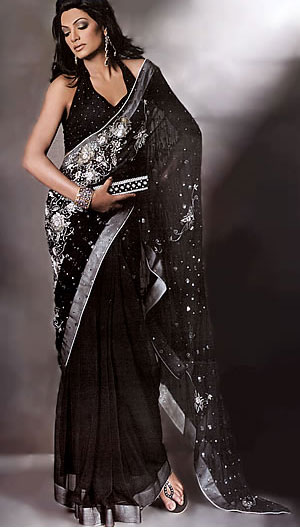Indian Saree Biography
source (google.com.pk)









source (google.com.pk)
The
word sari is derived from Sanskrit which means 'strip of cloth orsāḍī
in Prakrit, and which was corrupted to sāṛī in Hindi. The word 'Sattika'
is mentioned as describing women's attire in ancient India in Buddhist
Jain literature called This could be equivalent to modern day 'Sari' In
the history of Indian clothing the sari is traced back to the Indus
Valley Civilisation, which flourished during 2800–1800 BC around the
western part of the Indian subcontinent The earliest known depiction of
the sari in the Indian subcontinent is the statue of an Indus Valley
priest wearing a drape.Ancient Tamil poetry, such as the Silappadhi
karam and the Sanskrit work, Kadambari by Banabhatta, describes women in
exquisite drapery or sari.The ancient stone inscription from
Gangaikonda Cholapuram in old Tamil scripts has a reference to hand
weaving. In ancient Indian tradition and theNatya Shastra (an ancient
Indian treatise describing ancient dance and costumes), the navel of the
Supreme Being is considered to be the source of life and creativity,
hence the midriff is to be left bare by the sari. Sculptures from the
Gandhara, Mathura and Gupta schools (1st–6th century AD) show goddesses
and dancers wearing what appears to be a dhoti wrap, in the "fishtail"
version which covers the legs loosely and then flows into a long,
decorative drape in front of the legs. No bodices are shown. Other
sources say that everyday costume consisted of a dhoti or lungi
(sarong), combined with a breast band called 'Kurpasika' or 'Stanapatta'
and occasionally a wrap called 'Uttariya' that could at times be used
to cover the upper body or head. The two-piece Kerala mundum neryathum
(mundu, a dhoti or sarong, neryath, a shawl, in Malayalam) is a survival
of ancient Indian clothing styles. The one-piece sari is a modern
innovation, created by combining the two pieces of the mundum neryathum.
It is generally accepted that wrapped sari-like garments for lower body
and sometimes shawls or scarf like garment called 'uttariya' for upper
body, have been worn by Indian women for a long time, and that they have
been worn in their current form for hundreds of years. In ancient
couture the lower garment was called 'nivi' or 'nivi bandha', while the
upper body was mostly left bare. The works of Kalidasa mentions
'Kurpasika' a form of tight fitting breast band that simply covered the
breasts. It was also sometimes referred to as 'Uttarasanga' or
'Stanapatta'.The tightly fitted, short blouse worn under a sari is a
choli. Choli evolved as a form of clothing in the 10th century AD, and
the first cholis were only front covering; the back was always bare but
covered with end of saris pallu. Bodices of this type are still common
in the state of Rajasthan. n South India and especially in Kerala, women
from most communities wore only the sari and exposed the upper part of
the body till the middle of the 20th century. Poetic references from
works like Silappadikaram indicate that during the Sangam period in
ancient Tamil Nadu, a single piece of clothing served as both lower
garment and head covering, leaving the midriff completely uncovered.
Similar styles of the sari are recorded paintings by Raja Ravi Varma in
Kerala. By the mid 19th century, though, bare breasted styles of the
sari faced social revaluation and led to the Upper cloth controversy in
the princely state of Travancore (now part of the state of Kerala) and
the styles declined rapidly within the next half a century. In ancient
India, although women wore saris that bared the midriff, the
Dharmasastra writers stated that women should be dressed such that the
navel would never become visible. By which for some time the navel
exposure became a taboo and the navel was concealed.
Indian Sari Photos Images Pictures 2013

Indian Sari Photos Images Pictures 2013

Indian Sari Photos Images Pictures 2013

Indian Sari Photos Images Pictures 2013

Indian Sari Photos Images Pictures 2013

Indian Sari Photos Images Pictures 2013

Indian Sari Photos Images Pictures 2013
Indian Sari Photos Images Pictures 2013

Indian Sari Photos Images Pictures 2013

Indian Sari Photos Images Pictures 2013

Indian Sari Photos Images Pictures 2013

No comments:
Post a Comment